ORIF - Lag screw with antiglide plate
1. General considerations
Treatment principle
Articular fractures that have proximal extension into the metadiaphysis require addition of a neutralization or compression plate.
There are two options for definitive fixation with compression across the articular fracture, which may be combined:
- Lag screw outside a plate
- Compression with forceps and holding it with a locking screw through a plate
Here the application of intrinsic compression with an independent lag screw outside the plate is described.
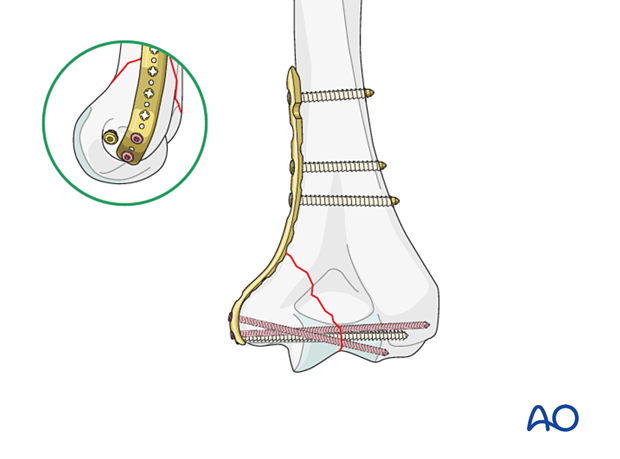
Triangle-of-stability concept
The mechanical properties of the distal humerus are based on a triangle of stability, comprising the medial and lateral columns and the articular block (see also the anatomical concepts).

Plate selection
Precontoured anatomical plates have been designed. If these are not available, a reconstruction plate may be used. If a stronger plate is required for either column, a small-fragment compression plate may be used, but this is more difficult to contour.
The medial plate with extension is designed to wrap around the medial epicondyle. This allows a higher variation of screw trajectories, especially an ascending screw insertion.
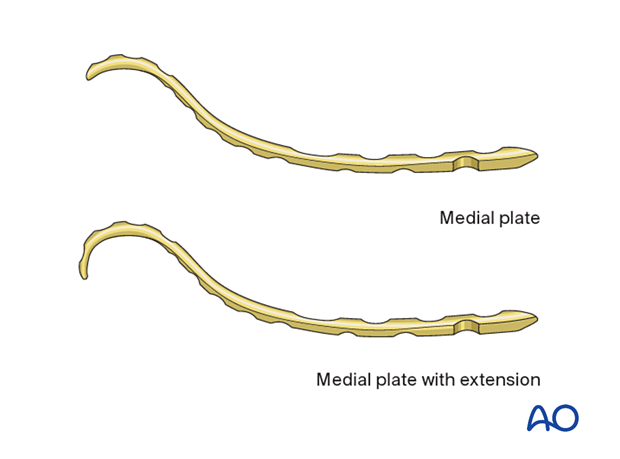
Screw selection
The screws that cross the fracture site should normally only have thread purchase in the far fragment to apply interfragmentary compression.
In the shaft, 2.7 and 3.5 mm screws are most commonly used.
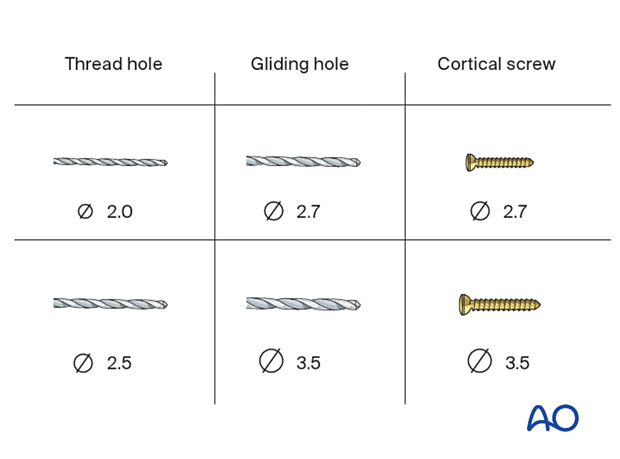
The articular screws are 2.7 mm low-profile metaphyseal and VA-LCP locking screws. The type of screw used depends on the desired fixation when planning for a lag/position screw within the plate.
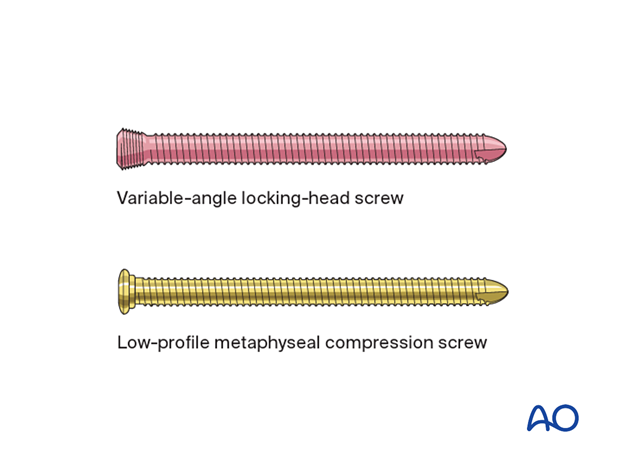
Note: ulnar nerve exposure and protection
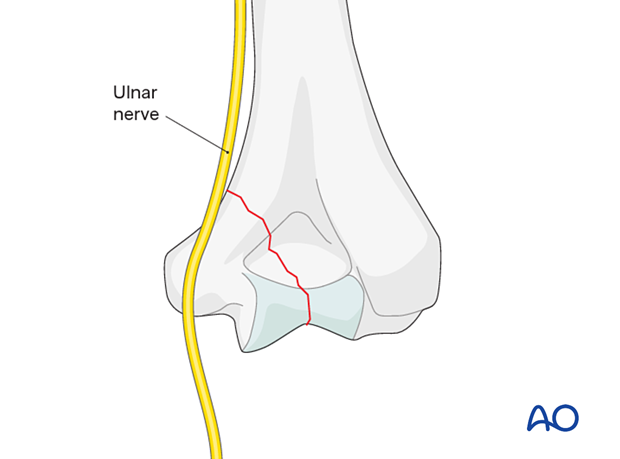
2. Patient preparation and approach
Patient positioning
This procedure is normally performed with the patient in a supine position.
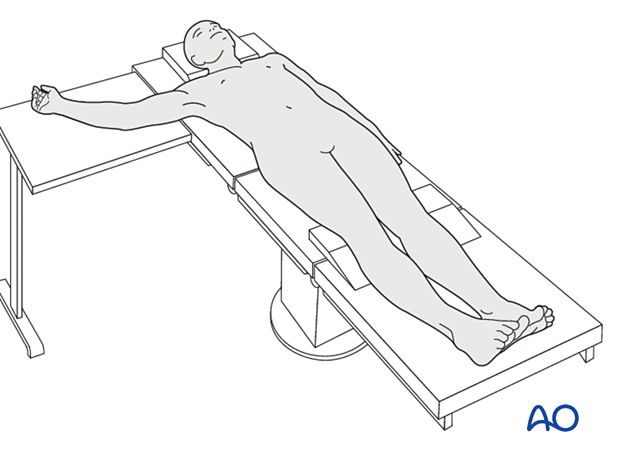
Approach
The preferred approach is the direct medial approach. This provides access to the ulnar nerve, the medial fracture fragment, and the ulnohumeral joint.
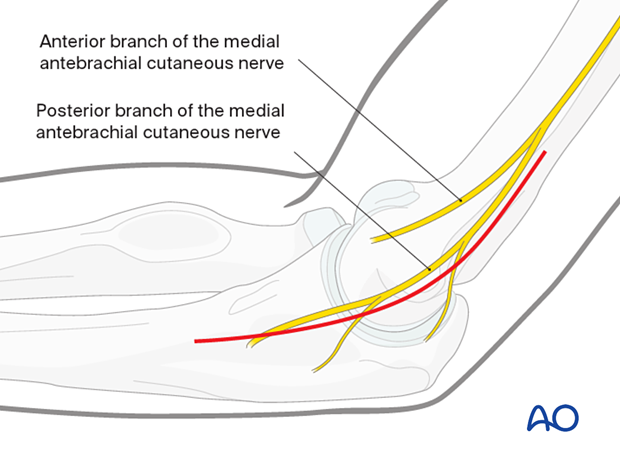
3. Reduction and temporary fixation
Mobilizing the fragment
Identify and protect the ulnar nerve (see also neurological protection and handling).
Open the fracture site by gently retracting the fragment anteriorly.
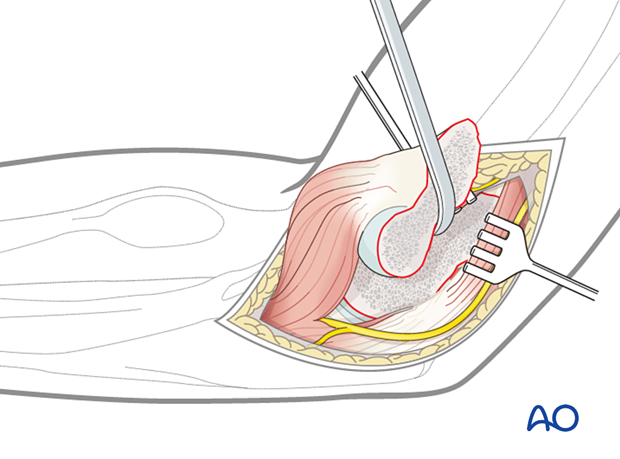
Clearing the fracture site
Clear the fracture of any hematoma, loose pieces of bone, or interposed tissue.
Inspect the joint surface to ensure that there is no additional intraarticular fracture extension.
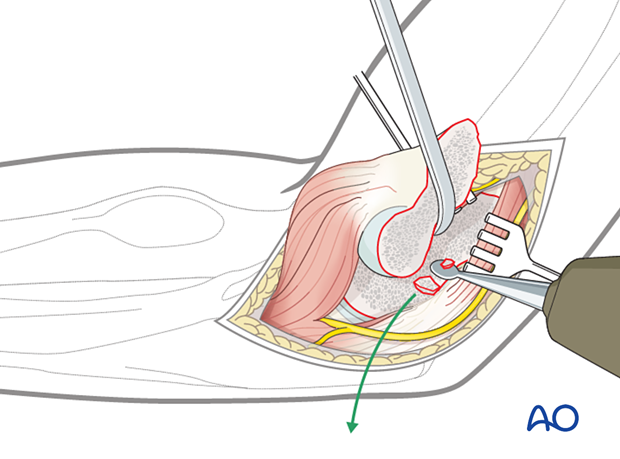
Reduction
Align the fracture and maintain reduction with a small hook or pick.
Monitor fracture reduction by realigning the metaphyseal fracture lines.
Depending on the extent of exposure, check the anterior and posterior fracture lines, including the articular surface.

Provisional fixation with K-wires
Before inserting K-wires, hold the reduction with forceps.
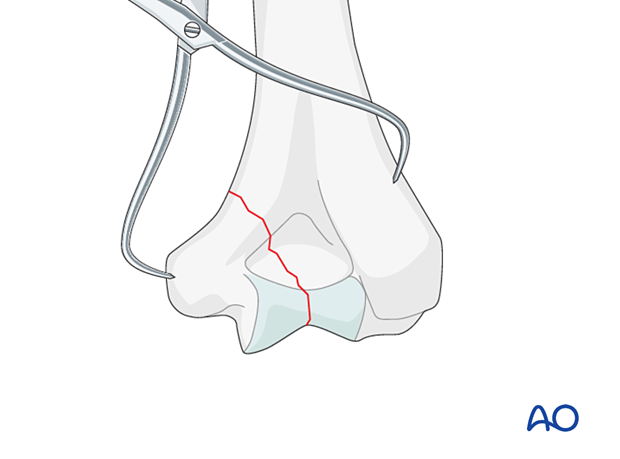
Maintain the reduction with smooth K-wires at least 1.6 mm in diameter. Insert the wires so they do not hinder plate placement.
Provisional wires may also be inserted through a plate screw hole or adjacent to the plate.
If necessary, check the reduction and provisional fixation with image intensification.
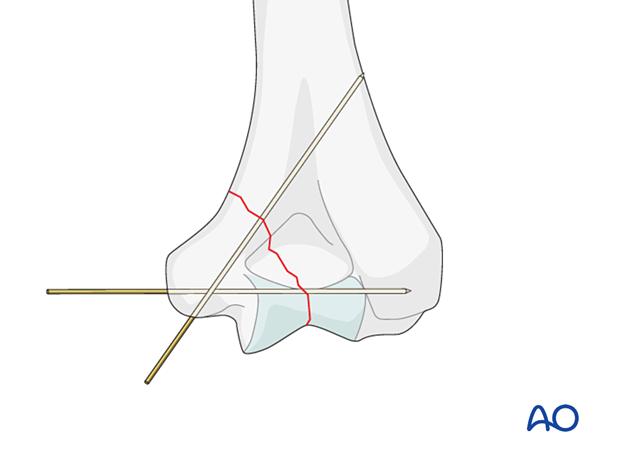
4. Lag screw insertion
Considerations for screw placement
The lag screw should be placed as distally as possible to ensure good compression of the articular surface fragments and minimal interference of the intended plate position. The screw should be as long as possible.
Drilling
For a fully threaded lag screw, drill the near fragment with a 2.7/3.5 mm drill to create a gliding hole.
Then drill the far fragment with a 2.0/2.5 mm drill.
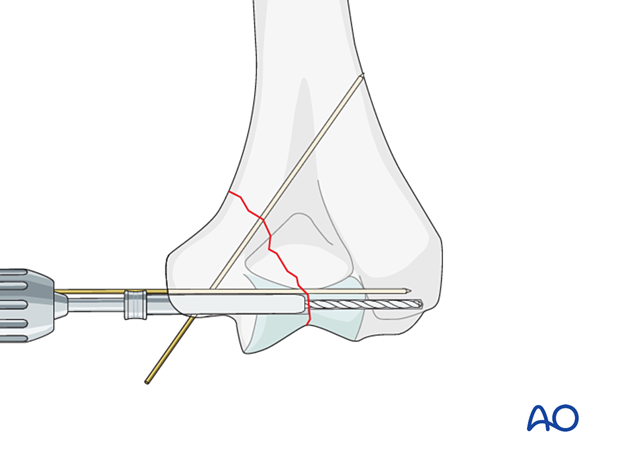
Screw insertion
Insert the screw and tighten it to compress the fragments.
Depending on the stability provided by the lag screw, the K-wires can then be removed.
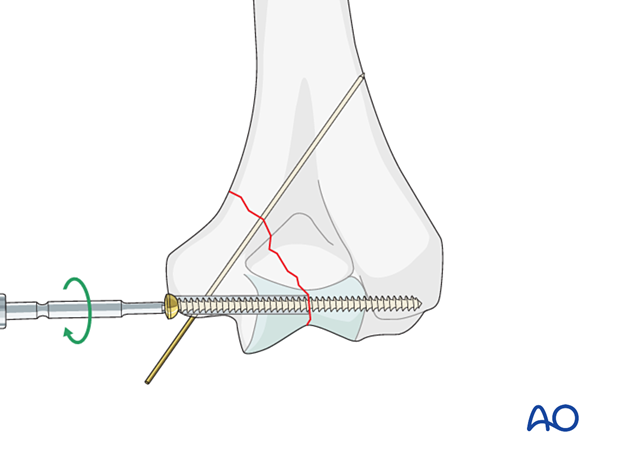
5. Plate application
Basic technique
The basic technique for application of anatomical plates is described in:
If precontoured anatomical plates are not available, see the basic technique for application of reconstruction plates.
Considerations for plate positioning
The plate should be positioned on the medial ridge, slightly dorsal to the intermuscular septum.
Due to the anatomy and/or the prominence of the screw head, it may be necessary to bend the plate. This ensures an optimal plate fit and positioning of long screws through the articular block.
Plate application
Apply the medial plate in neutral or compression mode.

6. Alternative: lag screw through the plate
When the medial plate is applied to the inferior edge of the epicondyle, the compression is applied in either way:
- Compression with forceps and holding it with a VA locking screw through the plate
- Insertion of a low-profile metaphyseal compression screw through the plate (shown in illustration)
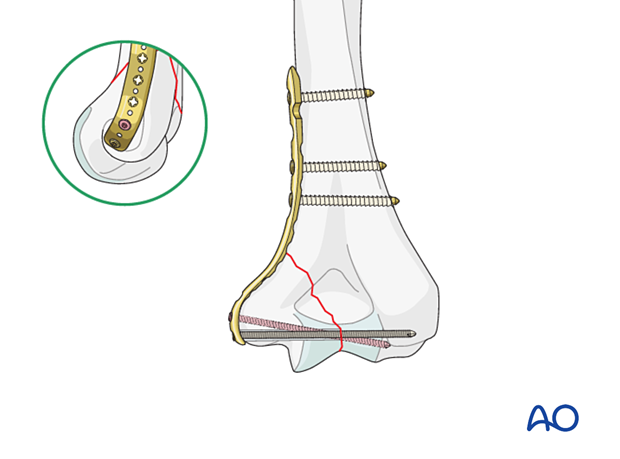
7. Alternative: medial plate with extension
An ascending column screw can be placed through the plate in a distal-to-proximal direction.
It is recommended that this ascending screw is inserted first and the further distal screws at variable angles to avoid screw interference.
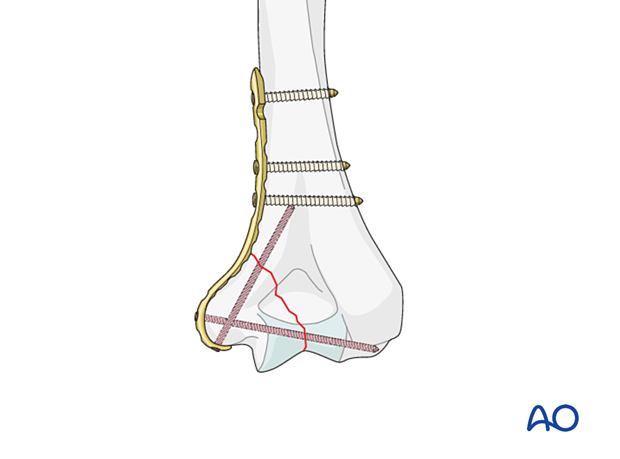
8. Final assessment
Visually inspect the fixation and manually check for fracture stability.
Repeat the manual check under image intensification.
Ensure the ulnar nerve is not unstable or tethered on implants throughout a full range of motion.
9. Aftercare
Introduction
The rehabilitation protocol consists usually of three phases:
- Rehabilitation until wound healing
- Rehabilitation until bone healing
- Functional rehabilitation after bone healing
Immediate aftercare
The arm is bandaged to support and protect the surgical wound.
The arm is rested on pillows in slight flexion of the elbow so that the hand is positioned above the level of the heart.
Short-term splinting may be applied for soft-tissue support.
Neurovascular observations are made frequently.
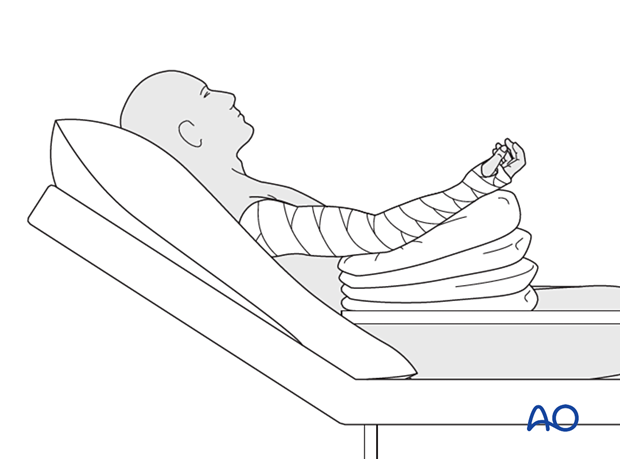
Hand pumping and forearm rotation exercises are started as soon as possible to reduce lymphedema and to improve venous return in the limb. This helps to reduce postoperative swelling.
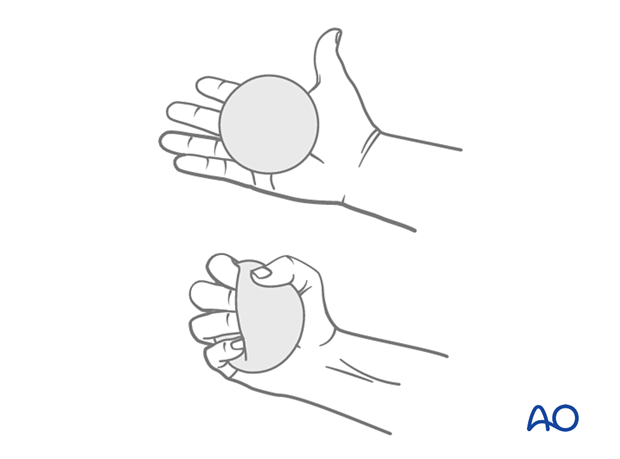
Mobilization until wound healing
Gravity-eliminated active assisted exercises of the elbow should be initiated as soon as possible, as the elbow is prone to stiffness:
- The bandages are removed, and the arm rested on a side table
- Flexion/extension of the arm at the elbow is encouraged in a gentle sweeping movement on the tabletop as far as comfort permits (as illustrated)
- Full pronation and supination in protected arm position is encouraged
- Exercises are performed hourly in repetitions, the number of which is governed by comfort
- Between periods of exercise, the elbow is rested in the elevated position for at least the first 48 hours postoperatively
- Keep the arm elevated between periods of exercise until the wound has healed
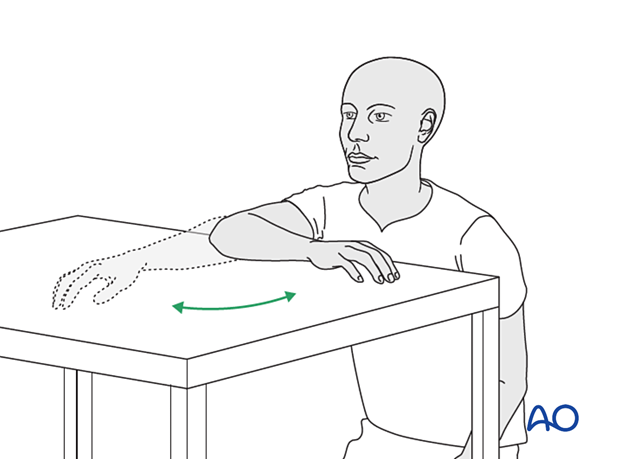
Rehabilitation until bone healing
Active patient-directed range-of -motion exercises should be encouraged without the routine use of splintage or immobilization.
Avoid forceful motion, repetitive loading, or weight-bearing through the arm.
A simple compressive sleeve can provide proprioceptive feedback which can help regain motion and avoid cocontraction.
No load-bearing (ie, pushing, pulling, or carrying weights) or strengthening exercises are allowed until early fracture healing is established by x-ray and clinical examination.
This is usually a minimum of 8–12 weeks after injury. Weight-bearing on the arm should be avoided until bony union is assured.
The patient should avoid resisted extension activities, especially after a triceps-elevating approach or olecranon osteotomy.
Rehabilitation after bone healing
When the fracture has united, a combination of active functional motion and kinetic chain rehabilitation can be initiated.
Active assisted elbow motion exercises are continued. The patient bends the elbow as much as possible using his/her muscles while simultaneously using the opposite arm to gently push the arm into further flexion. This effort should be sustained for several minutes; the longer, the better.

Next, a similar exercise is performed for extension.

If the patient finds it difficult to accomplish these exercises when seated, then performing the same exercises when lying supine can be helpful.
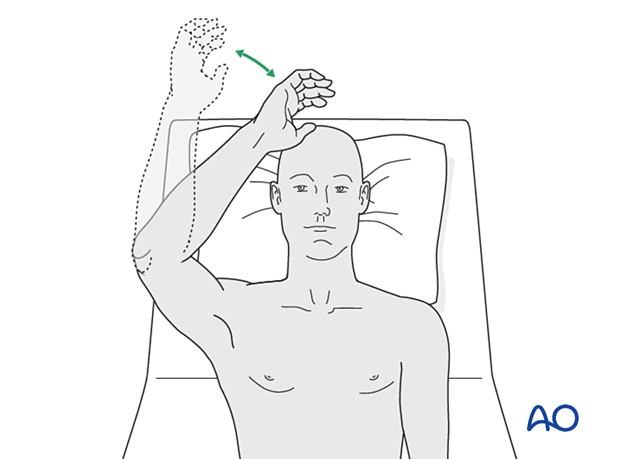
Implant removal
Generally, the implants are not removed. If symptomatic, hardware removal may be considered after consolidated bony healing, usually no less than 6 months for metaphyseal fractures and 12 months when the diaphysis is involved. The avoidance of the risk of refracture requires activity limitation for some months after implant removal.













